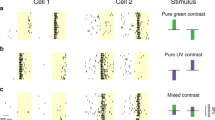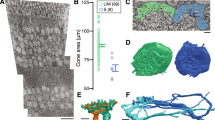Abstract
The dynamic range of visual coding is extended by having separate ganglion cell types that respond to light increments and decrements. Although the primordial color vision system in mammals contains a well-characterized ganglion cell that responds to blue light increments (a blue On center cell), less is known about ganglion cells that respond to blue light decrements (blue Off center cells). We identified a regular mosaic of blue Off center ganglion cells in the ground squirrel. Contrary to the standard scheme, blue Off responses came from a blue On bipolar and inverting amacrine cell.
This is a preview of subscription content, access via your institution
Access options
Subscribe to this journal
Receive 12 print issues and online access
$209.00 per year
only $17.42 per issue
Buy this article
- Purchase on Springer Link
- Instant access to full article PDF
Prices may be subject to local taxes which are calculated during checkout


Similar content being viewed by others
References
Yin, L. et al. J. Neurosci. 29, 2706–2724 (2009).
Dacey, D.M. & Lee, B.B. Nature 367, 731–735 (1994).
Field, G.D. et al. J. Neurosci. 27, 13261–13272 (2007).
Hemmi, J.M., James, A. & Taylor, W.R. J. Vis. 2, 608–617 (2002).
Dacey, D.M. in The Cognitive Neurosciences (ed. Gazzaniga, M.S.) 281–301 (MIT Press, Cambridge, Massachusetts, 2004).
Dacey, D.M. et al. Nature 433, 749–754 (2005).
Michael, C.R. J. Neurophysiol. 31, 268–282 (1968).
Jacobs, G.H. & Tootell, R.B. J. Neurophysiol. 45, 891–902 (1981).
Wiesel, T.N. & Hubel, D.H. J. Neurophysiol. 29, 1115–1156 (1966).
Tailby, C. et al. J. Physiol. (Lond.) 586, 5947–5967 (2008).
Litke, A.M. et al. IEEE Trans. Nucl. Sci. 51, 1434–1440 (2004).
Kryger, Z. et al. Vis. Neurosci. 15, 685–691 (1998).
Li, W. & DeVries, S.H. Nat. Neurosci. 9, 669–675 (2006).
Crook, J.D. et al. J. Neurosci. 29, 8372–8387 (2009).
Manookin, M.B. et al. J. Neurosci. 28, 4136–4150 (2008).
Saszik, S. & DeVries, S.H. J. Neurosci. 32, 297–307 (2012).
Ala-Laurila, P. et al. Nat. Neurosci. 14, 1309–1316 (2011).
Kraft, T.W. J. Physiol. (Lond.) 404, 199–213 (1988).
Wässle, H. & Riemann, H.J. Proc. R. Soc. Lond. B Biol. Sci. 200, 441–461 (1978).
Petrusca, D. et al. J. Neurosci. 27, 11019–11027 (2007).
Acknowledgements
We thank A.M. Litke for technical development and scientific discussions, W. Dabrowski, K. Mathieson, P. Hottowy and S. Kachiguine for technical development, M. Krause and J. Roebber for technical assistance with the experiments, and G.D. Field and B. Szmajda for providing comments on the manuscript. This work was supported by a US National Institutes of Health grant (R01EY018204) to S.H.D. and a Burroughs Wellcome Fund Career Award at the Scientific Interface to A.S.
Author information
Authors and Affiliations
Contributions
The authors contributed equally to this work.
Corresponding authors
Ethics declarations
Competing interests
The authors declare no competing financial interests.
Supplementary information
Supplementary Text and Figures
Supplementary Figures 1–5 (PDF 741 kb)
Rights and permissions
About this article
Cite this article
Sher, A., DeVries, S. A non-canonical pathway for mammalian blue-green color vision. Nat Neurosci 15, 952–953 (2012). https://doi.org/10.1038/nn.3127
Received:
Accepted:
Published:
Issue Date:
DOI: https://doi.org/10.1038/nn.3127
This article is cited by
-
Neural circuits in the mouse retina support color vision in the upper visual field
Nature Communications (2020)
-
Evolution of the circuitry for conscious color vision in primates
Eye (2017)
-
Large scale matching of function to the genetic identity of retinal ganglion cells
Scientific Reports (2017)
-
A genetic and computational approach to structurally classify neuronal types
Nature Communications (2014)
-
Inverting the blues
Nature Reviews Neuroscience (2012)



